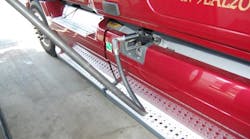Average retail pump prices for diesel and gasoline continued to decline across the U.S. with two minor exceptions, according to data tracked by the Energy Information Administration (EIA), though an uptick in global oil prices and a slowdown in domestic production activity could change things.
The national average retail pump price for diesel dropped 6.7 cents this week to $2.866 per gallon, the agency said, which is $1.038 per gallon cheaper compared to the same week in 2014.
Diesel prices decreased in every region of the U.S. this week, EIA noted, with prices above the $3 per gallon mark in only three areas: New England at $3.018 (down 5.4 cents from last week), the Central Atlantic at $3.078 (down 5.3 cents) and California at $3.090 (down 7.5 cents).
The Midwest recorded the biggest one-week dip in diesel prices – an 8.5 cent slide to $2.084 per gallon – while the West Coast without including California sported the lowest price for diesel in the country: $2.763 per gallon after falling 6.3 cents this week.
EIA added, however, that with California included, the West Coast’s average retail pump price for diesel sits at $2.942 per gallon after declining 6.9 cents compared to last week.
The national average retail pump price for gasoline fell 2.2 cents to $2.044 per gallon this week, the agency said, which is $1.251 per gallon cheaper compared to the same week in 2014.
Though the Midwest and Gulf Coast reported upticks in gasoline prices this week – a 1.8 cent and 6/10ths of penny per gallon increase, respectively – both are among the three regions where gasoline prices slid under $2 per gallon.
Average retail pump prices for gasoline sit at $1.936 for the Midwest and $1.850 for the Gulf Coast, with the Rocky Mountains at $1.873 after recording a 3.5 cent per gallon dip this week.
California witnessed the largest one-week decline in gasoline prices, EIA noted, sporting a 7.7 cent drop to $2.19 per gallon.
Yet the agency cautions that forecasting what the future holds for U.S. fuel prices is challenging, in part because the uncertainty over the global oil price outlook is being reflected in the current values of futures and options contracts.
Global oil prices still turn upwards this week, though only minutely and largely due to currency exchange rate activity.
Yet EIA said the sharp decline in oil prices over the last quarter of 2014, which has continued in January, is already having a significant effect on oil drilling activity in the U.S., with onshore drilling rig activity declining 16% in the Lower 48 states between October and January, according to data from Baker-Hughes.
The growing uncertainty surrounding oil prices presents a major challenge to all price forecasts, EIA stressed, with its most recent Short-Term Energy Outlook (STEO) – issued back in January – predicting Brent crude oil prices averaging $58 per barrel (bbl) in 2015 and $75/bbl in 2016, with annual average West Texas Intermediate (WTI) prices expected to be $3/bbl to $4/bbl lower.
Should that oil price forecast be realized, EIA projects that the number of operating rigs will then decrease by approximately 24% from January to October this year, before beginning to rebound in November.



